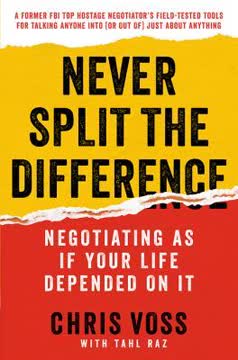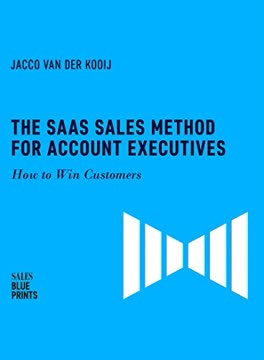Key Takeaways
1. Tailor Your Sales Methodology to the Customer
The ideal sales methodology is not the same for every customer or market.
Match your approach. Effective B2B sales requires adapting your methodology to the customer's specific needs, budget, and buying journey. A one-size-fits-all approach is inefficient and ineffective, as the effort invested must align with the potential deal size and complexity. Different sales methods are suited for varying Annual Contract Values (ACV) and sales cycle lengths.
Understand the spectrum. Sales methodologies range from fully automated to highly consultative.
- DIY Self-Service: Customers complete purchases online, ideal for low-cost, high-volume services.
- Transactional Selling: For customers who know what they want and are price-shopping (<$1,000 ACV, <30-day cycle). Sales is reactive, often web/chat-based.
- Solution Selling: Customers understand their problem and seek specific product/service features ($5,000 ACV, ~30-day cycle). Sales is reactive, often inbound.
- Consultative Selling: For complex problems where customers need help understanding the issue and solution ($20-100k ACV, 6-18 month cycle). Sales educates and diagnoses.
- Provocative Selling: For innovative solutions challenging the status quo, where customers don't realize they have a problem ($250k ACV, 3-9 month cycle). Sales provokes action.
Simplify the process. Regardless of the method, all sales approaches involve four core processes: Educating the market, Prospecting for fit, Winning the customer, and Growing the relationship. The "winning" process, which is the focus for Account Executives, involves nine key activities from identifying opportunities to securing commitment.
2. Master the Art of Customer Diagnosis
Great sales professionals start by asking questions to diagnose the situation, without emphasizing the company they work for or service they sell.
Always be curious. Effective sales begins with deep understanding, not immediate pitching. Rushing to present a solution before fully diagnosing the customer's situation is akin to malpractice. The goal is to engage with the intent to understand, building trust and setting the stage for a relevant solution.
Sequence your questions. Use the SPICED framework (Situation, Pain, Impact, Critical Event, Decision Process) to guide your diagnosis. Start by preparing thoroughly, then open the conversation professionally by setting a clear agenda and confirming what the customer wants to achieve. This ensures the discussion is customer-centric and addresses their priorities.
Listen and summarize. Ask open-ended questions to uncover their current situation (S), the problems or challenges they face (P), and the impact these pains have on their business (I). Actively listen, mirror emotional words, and summarize their situation and pains to confirm understanding. This demonstrates empathy and builds rapport, transitioning from emotional understanding to rational quantification of value.
3. Uncover True Impact and Critical Events
This impact determines the di erence between nice-to-have vs. must-have, and understanding this concept is what separates a good AE from a great AE.
Quantify the value. In a competitive SaaS market, focusing on features leads to price wars. Instead, identify the deep, underlying impact your solution can have. This involves peeling back layers of "needs" to uncover the true "must-have" value. Impact can generally be categorized into three types:
- Increase Revenue: Easiest to sell, as growth is a top priority (e.g., lead generation software).
- Reduce Cost: Focuses on efficiency, often at lower profit margins (e.g., online storage).
- Improve Customer Experience: Leads to productivity gains, often a step removed from direct revenue/cost, but provides a longer runway for success (e.g., CRM).
Identify the driving force. A critical event is a specific, high-stakes deadline or circumstance that drives a decision, carrying significant consequences if missed (e.g., a product launch, "Black Friday"). Distinguish this from a "compelling event," which is merely a nice-to-have. Ask: "When do you need this service to be live by?" followed by "...and what happens if you miss that date?"
Work backward from the deadline. Once a critical event is identified, work backward to map out all necessary steps and timelines. This "critical event timeline" should be co-created with the customer and confirmed in a standalone email. This helps prevent deals from "going dark" and aligns all stakeholders, ensuring the focus remains on the customer's desired outcome, not just your P/O date.
4. Navigate Complex Decision Processes with Orchestration
What is new is that we see buyers behavior trending away from the hierarchical decision process toward a consensus-driven decision process for organizational, and cultural reasons.
Understand the shift. Historically, B2B deals relied on a hierarchical decision model, where senior executives held primary purchasing authority. Today, with SaaS's lower price points, decisions are increasingly made by consensus committees. In this model, the end-user often holds significant sway, as their adoption is crucial for success.
Identify the decision type. Ask: "Have you bought a solution like this before? What was the decision process?"
- Hierarchy Model: Focus on navigating up the organizational chart to the highest possible level, aligning your company's executives with theirs (3x3 matrix). The AE's job is to gain executive support and coverage.
- Consensus Model: Identify all stakeholders across departments (users, managers, IT, legal, finance) who influence the decision. Anyone on the committee can derail the deal, making orchestration of communication and buy-in across all roles critical.
Orchestrate the journey. In consensus and provocative sales, orchestrating communication is paramount. This involves strategically planning who needs to be involved, when, and what information they need. For example, an enthusiastic user might initiate, leading to manager buy-in, then executive approval, followed by IT and finance checks. Mapping relationships and sentiment (positive, neutral, negative) for each stakeholder allows you to proactively address potential roadblocks and align your resources to secure broad organizational support.
5. Prescribe Solutions Through Insightful Storytelling
Prescription before diagnosis is malpractice.
Demonstrate, don't just tell. After a thorough diagnosis, it's time to show how your solution helps. This can be done by sharing customer stories, demonstrating the product, or provoking action. The most effective way to do this is through storytelling, following a "Why, How, What" structure. Start with the market problem (Why), explain your conceptual approach (How), then describe your practical solution (What).
Engage with purpose. When demonstrating your product, avoid the "sh!t show" monologue. Instead, re-engage the customer by:
- Confirming their top challenges and desired outcomes.
- Briefly describing the screen layout, highlighting what not to focus on.
- Explaining why you're showing a particular feature in their context.
- Asking if what you showed was relevant or helpful, and immediately diagnosing their feedback.
- Handing over controls to let them "test drive" the solution.
Provoke action strategically. Provocative selling is reserved for handpicked accounts with high impact potential and executive access. It involves deep research to understand the customer's world better than they do, then educating them with new insights that reframe their business challenges. The goal is to deliver a "vision pitch" and a "provocative statement" (e.g., "Your current approach is costing you $10M/year. If you don't change, you will lose 12% market share in the next 12 months.") that drives immediate action, backed by a strong business case and emotional impact.
6. Control Decision Criteria to Win Deals
The decision criteria are like the four center squares of a chess board. Control them, and your chances of winning the game radically increase.
Influence the evaluation. Early engagement allows you to shape the customer's decision criteria. Start by asking about their key factors for choice and identifying competitors. Then, prioritize these criteria with the customer, understanding what truly matters most to them. Crucially, assess where you stand against competitors on each criterion (first, second, or third).
Reprioritize and add criteria. Your goal is to increase the priority of criteria where your solution excels (especially those with high business impact) and decrease the importance of criteria where you are weak. Don't be confined by the customer's initial framework; introduce new criteria where you have a unique advantage, such as "simplicity of use," and educate the customer on its long-term impact (e.g., adoption rates).
Improve your ranking. For existing criteria, continuously provide deeper insights, statistics, demonstrations, and reference calls to improve your perceived ranking. Persistence and confidence in your solution are key differentiators. This fluid process requires constant adaptation as new decision-makers get involved or competitors adjust their positioning.
7. Compete Effectively by Focusing on Customer Needs
Buyers don’t care about your solution. They care about removing the roadblocks to accomplishing their objectives and to be more successful.
Focus on value, not features. When competing, avoid the trap of a feature-by-feature comparison, which quickly devolves into a price discussion. Instead, focus intensely on uncovering the customer's needs and demonstrating how your offering provides real, measurable impact on their business. Your knowledge of their needs and your solution's ability to meet them is your primary competitive advantage.
Place "mines" strategically. Since customers can easily research competitors, proactively address known competitive strengths by "placing mines." This means educating the customer on questions to ask your competitors that highlight their weaknesses or make their positioning less important. For example, if a competitor boasts about a specific feature, you might educate the customer on why that feature isn't a critical decision criterion for their long-term success.
Assist the selection process. Your role is to be a knowledgeable, non-emotional, and sincere trusted advisor.
- Establish and prioritize customer needs (decision criteria) from the first interaction.
- Capture their exact words and repeat them back.
- Change decision criteria in your favor by moving advantageous criteria up, disadvantageous ones down, or adding new ones.
- Improve your ranking through insights, demos, and references.
- For incumbents, focus on what they promised but didn't deliver, and tease new functionality.
8. Propose Value, Not Just Price
It presents the value your service will create for the customer, e.g. buy $1 get $5.
Shift from discount to trade. Instead of simply offering discounts, frame pricing discussions as a "trade." This means exchanging value for value. Prepare a list of "goods" or "services" you can offer in return for concessions, such as a video case study, logo use, or a CEO introduction to a new account.
Build a transparent proposal. Use a screen share or shared document to build the proposal collaboratively. Standardize your quotes and proposals, ensuring they include:
- Expiration Date: Creates urgency.
- Price Adjustment: Note conditions for any price changes, not "discounts."
- Specific Returns: Clearly state what you receive in exchange for price adjustments.
- Renewal Terms: Set clear terms for future years to avoid extending initial concessions.
- Payment Terms: Outline conditions of sale.
Create an impact proposal. For larger deals, move beyond a simple quote to a multi-page impact proposal. This document outlines the problem, key value points, specific pain points, their negative business impact (quantified ROI), practical examples, your plan, deliverables, involved parties, timeline, and clear terms. Crucially, it educates the customer on trade-offs, comparing your solution not just against competitors, but also against substitutes, the cost of doing nothing, and the cost of delay.
9. Manage Delays with Strategic Nurturing
The most common reason for losing a deal is extended delay.
Avoid harassment, enable tracking. When a deal goes quiet, resist the urge to constantly check in, which can annoy the customer. Instead, ensure all proposals, presentations, and emails are enabled with tracking software. This allows you to monitor engagement and take immediate action when the customer re-engages with your materials.
Implement a slow-drip campaign. Continue to provide valuable insights through a customized drip campaign. This "Fear Of Missing Out" (FOMO) approach educates the customer on what others in their industry are achieving and the benefits they are gaining.
- Personalize content: Hand-pick articles (third-party and use-cases) that match the customer's specific situation and persona (e.g., C-suite cares about strategy, managers about team motivation).
- Highlight relevance: Always point out the specific paragraph or insight you think is most relevant, rather than just sending a generic PDF.
- Focus on their success: Frame insights around how they can get promoted or solve their problems, not just about your company.
Set effective alerts. Proactively monitor your lost or delayed accounts for triggers that indicate a change in their situation, such as new funding rounds, executive hires, office moves, or increased hiring. Tools like Google Alerts, Owler, LinkedIn Saved Searches, and industry-specific portals can help you stay informed and re-engage at the opportune moment.
10. Trade Value, Don't Just Discount, to Close
A customer raising an objection is them expressing the interest to buy.
Negotiation as a process. View negotiation not as a single event, but as an ongoing process of understanding and value exchange. When a customer raises an objection, it's often a sign of interest. Your goal is to uncover the real objection, which may be several layers deep.
Follow a step-by-step negotiation checklist:
- Understand the customer's situation: Impact, critical event, decision criteria, key elements (price, terms).
- Know your counterpart: Understand their communication style.
- Get all items on the table: Price, terms, setup fees, etc.
- Prioritize issues: Ask what's most important to them.
- Confirm decision-making authority: Ensure they can commit by a specific date.
- Give reluctantly, get in return: For every concession, ask for something in return (e.g., a faster close, a case study).
- Confirm in writing: Immediately send an email summarizing the agreed terms.
- Set expiration dates: Clearly state when the offer expires and the consequences of missing the deadline.
Handle price objections effectively. When confronted with "Your price is too high," ask:
- "Compared with what?" or "Can you explain that?" to understand the basis of the objection.
- "Are you ready to commit now?" to ensure they are serious about buying.
- "Is pricing the only remaining issue?" to uncover any hidden concerns.
- "Please share with me what the price difference is, and I'll do my very best to narrow the gap," to get concrete numbers.
This systematic approach ensures you address the true concerns and trade value strategically, rather than just giving away margin.
Last updated:
Review Summary
The SaaS Sales Method for Account Executives receives high praise for its practical approach to modern B2B sales. Readers appreciate its actionable takeaways, email templates, and question examples. The book is described as concise, effective, and applicable beyond just SaaS. Many find it a valuable resource for developing a mature sales process. While some note stylistic issues like typos, the overall consensus is that it provides a solid foundation for sales excellence. Readers particularly value its simplicity, rich content, and visual aids in explaining sales concepts.
Similar Books










Download PDF
Download EPUB
.epub digital book format is ideal for reading ebooks on phones, tablets, and e-readers.






